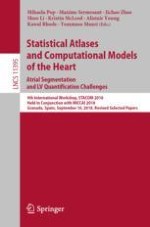
2019 | OriginalPaper | Buchkapitel
Estimating Sheets in the Heart Wall
verfasst von : Tabish A. Syed, Babak Samari, Kaleem Siddiqi
Erschienen in: Statistical Atlases and Computational Models of the Heart. Atrial Segmentation and LV Quantification Challenges
Aktivieren Sie unsere intelligente Suche, um passende Fachinhalte oder Patente zu finden.
Wählen Sie Textabschnitte aus um mit Künstlicher Intelligenz passenden Patente zu finden. powered by
Markieren Sie Textabschnitte, um KI-gestützt weitere passende Inhalte zu finden. powered by